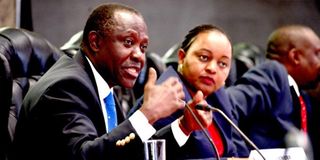Season to share fresh pot of resources

Parliamentary budget committee chairman Mutava Musyimi, Devolution and Planning Cabinet Secretary Ann Waiguru and Treasury CS Henry Rotich during medium term expenditure framework hearings in Nairobi on December 9, 2014. FILE PHOTO | SALATON NJAU |
What you need to know:
- Counties upbeat as sector hearings for next medium term expenditure kick off.
Counties have recently started a series of “sector hearings” for the 2015/16 budget, sometimes also called “medium term expenditure framework” hearings.
This is just fancy jargon for budgeting over three years instead of just one.
What is this moment in the budget cycle all about?
One way to think about the budget process is as a series of negotiations between interested parties.
These negotiations, among the county executive, county assembly and the public, take place over nearly 10 months (from September to June).
What are these negotiations about? Every year, we have a new pot of resources to share.
Health, agriculture, etc, fight over how much of this pot they should be given. One key moment in the negotiations is the decision about how much will go to each. We are nearing that moment.
What money are we actually fighting about? While most county money can theoretically be spent on anything, the reality is that the government has a number of ongoing commitments that reduce the amount of money available for new projects each year.
For example, in most counties, salaries to health workers make up a large share of the budget. Counties also have to spend money on operations and maintenance.
Finally, capital projects started in the current year may require more money in the next year to be completed.
We want to finish buildings we have started, not leave them half completed because we didn’t budget for costs in future years.
SMALLER AMOUNT OF MONEY
Taken together, this means that we have a much smaller amount of money available each year that we can actually debate and decide how to use.
So who’s in charge of dividing up the pot? In the process of deciding who gets what, the county treasury plays the role of clarifying the total amount available to be divided up.
The other agencies are responsible for determining their top priorities and “bidding” for as much money as they need to achieve their objectives.
The Treasury must ensure that all of the proposals from different agencies do not exceed what is available.
So how does the process flow? The first step is for the county treasury to provide guidelines to ministries and agencies on how to make their proposals for new spending for the year.
The August 30 circular explains to ministries how to make their bids: the format and the timeline for bidding, but also the overall county priorities for the year that sector bids must align with if they hope to be successful.
After the circular, ministries and agencies are expected to get to work on their bids.
This is normally done through what are called “sector working groups” at the national level. The sector working groups are meant to consist of all key executive agencies in a sector.
For example, health might include the Ministry of Health, but also all the state corporations and other health-related departments. The working group will develop a bid for each sector, and try to convince Treasury to give them as much money as possible.
One of the key inputs into the sector bid is a provisional “ceiling” provided by Treasury. This ceiling (the maximum funding available to the sector) is to be provided in the county budget review and outlook Paper, which should be finalised by November of each year.
Essentially, the work of the sector working groups is to make the most effective bid possible for resources. The final ceilings are then set at the end of February in the County Fiscal Strategy Paper, which is approved by the County Assembly.
Where does the public come in? The government is legally required to get input from the public into the Fiscal Strategy Paper.
This input should relate to the question of how much each sector will get: whether to change the provisional ceilings from the county budget review and outlook or to leave them.
This becomes a critical input into Treasury’s final decision about how to adjust the ceilings before presenting the Fiscal Strategy Paper to the Assembly in February.
Discussions on the final details of what each sector will do are meant to happen in May. This is the final stage of talks before the budget is approved.
Dr. Lakin is the Country Manager of International Budget Partnership Kenya.




